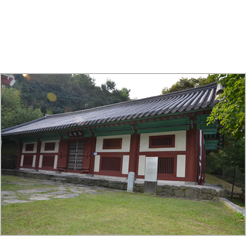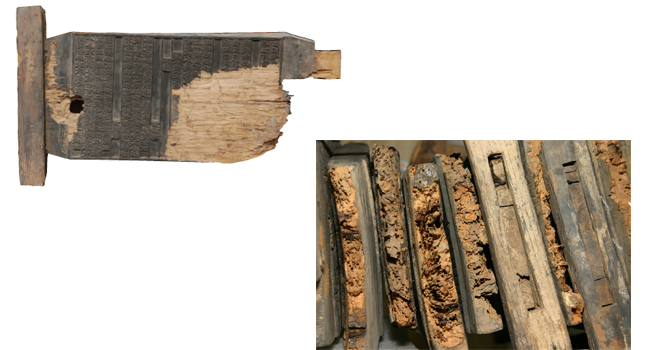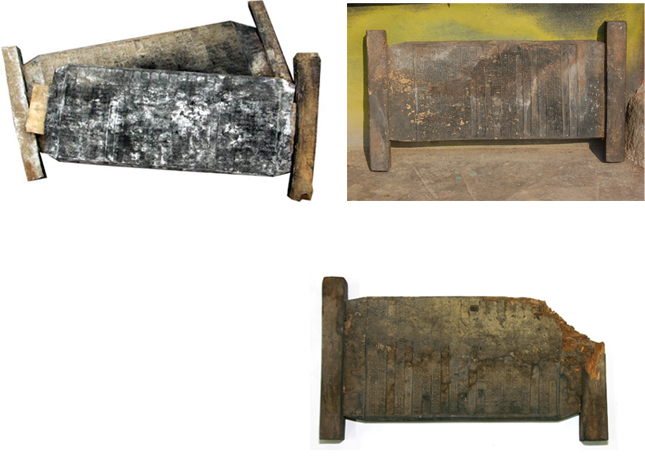E-mail : master@koreastudy.or.kr
Tel : 82-54-851-0700
The Advanced Center for Korean
Studies copyright ⓒ2014
Preservation of Woodblocks
1. Establishment of Jangpangak
Woodblocks are durable and can be used repeatedly for a long time. For the purpose of storing these woodblocks, new buildings are sometimes constructed, and these are called “jangpangak (Warehouse for storage of woodblocks).”

Korean Studies Andong-si, Gyeongsangbuk-do.

Songjadaejeon Located in Uam
Historic Park, Daejeon.
A traditional jangpangak has a wood floor 10 to 20 centimeters above the ground. Three sides have no windows, and the front has windows covered by vertical bars.

Inside of Jangpangak of the Advanced Center For Korean Studies
Andong-si, Gyeongsangbuk-do.
n actuality, such a structure is not suitable for storing woodblocks. The wood used to make woodblocks is seasoned by boiling in salt water and drying for several years, so its moisture content is relatively stable. However, when there are no windows, the lack of ventilation becomes a problem when humidity is high, such as the monsoon season, and it breeds mold. Also, the wood floor reduces the amount of moisture entering the building from the ground, and on extremely dry days, this lack of moisture can cause problems for the woodblocks. In other words, air circulation is the most important factor in a jangpangak. Because there are no windows there is insufficient air circulation, so the moisture from the ground cannot escape the building. Temple Haein-sa’s Buddhist Hall (the name for their jangpangak) for the Tripitaka Koreana has windows of different sizes solely to provide for natural air flow. This illustrates the relative importance of ventilation in a jangpangak.
2. Dust and ink
However well-constructed a jangpangak is to provide for air flow, it cannot prevent the accumulation of dust. The proper thing to do would be to remove the dust on a regular basis, but in reality, clan or private houses that store woodblocks generally do not remove the dust for long periods of time. Dust blocks the natural moisture control function of woodblocks. In high humidity, dust prevents the moisture in the woodblocks from escaping, and bacteria and mold will develop and damage the woodblocks.
 A woodblock damaged by
A woodblock damaged by
pyralidid, a parasite living in a
tree
End pieces damaged by pyralidid
When a book is printed with woodblocks, ink is applied to its surface, which will penetrate slightly into the wood. This absorbed ink acts as a kind of protective film and helps preserve the wood. However, when foreign matter is introduced, it may damage the wood. In order to get a clear printing with a woodblock, glue is often mixed with ink, but the starch in the glue may feed the microorganism and can damage the board.<Imwongyengjeji>says, “After printing is done, the woodblock shall be washed clean with salt water, and after drying, will be preserved in the shade.” This is to prevent possible damage that could be caused by bad ink. Pure ink helps preserve the block, but when dust accumulates over the ink, the woodblock will retain more moisture and cause mold or decay. Harmful microorganisms and molds breed most when the humidity is 80 percent or higher and when the temperature ranges from 20 to 30 degrees Celsius. Even in a modern jangpangak with constant temperature and humidity controls, mold may infect woodblocks because of people entering the building or the door being open on rainy days, causing the humidity inside to go up and the moisture content of the woodblock to increase. Plus, visitors exhale carbon dioxide and bring in dust, and even small amounts can damage woodblocks by affecting its moisture content. Therefore, such facilities need constant supervision and care.
 Woodblock with moss on its
Woodblock with moss on its
surface due to moisture
Woodblock damaged by dust
and other foreign materials

